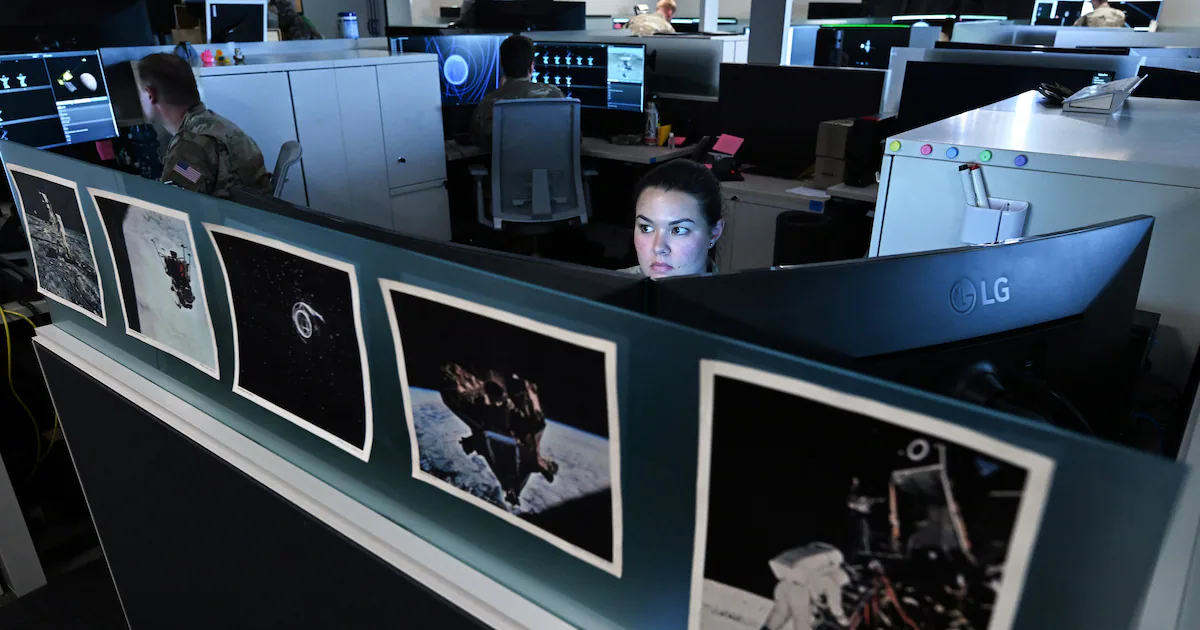
JOINT BASE PEARL HARBOR-HICKAM, Hawaii – It looked more like a satellite television dish than a weapon. But the antenna could fire enough electromagnetic energy to fry the satellite 22,000 miles away.
That was not the plan for tonightŌĆÖs attack, however.
Instead, the salvo would be more covert – millisecond pulses of energy that would subtly disrupt the satelliteŌĆÖs signals, which U.S. military forces were using to communicate in the Pacific Ocean. The goal was to disguise the strike as a garbled connection that could be easily remedied by securing a loose cable or a simple reboot, leaving U.S. service members frustrated without raising their suspicions.
This is how the next war could start: invisible shots fired in space on the electromagnetic spectrum that could render U.S. fighter jets and aircraft carriers deaf and blind, unable to communicate. In this case, the ŌĆ£aggressorsŌĆØ targeting the U.S. satellite were not from China or Russia, but rather an elite squadron of U.S. Space Force Guardians mimicking how potential adversaries would act in a conflict that begins in orbit.
The July combat training exercise marked the largest one led by the Space Force, the highly secretive branch of the military with an exclusive focus on combating threats in the vast expanse beyond EarthŌĆÖs atmosphere.
More than five years after it was created, the Space Force, the most derided and misunderstood branch of the U.S. military, has emerged as a vital part of the American war machine as space becomes increasingly militarized. But even its leaders acknowledge that they are still honing their mission while jousting with adversaries, such as China, that are moving quickly and conducting combat-like operations in orbit.
Involving more than 700 service members and spanning 50 million square miles and six time zones, the training exercise, called Resolute Space, was observed firsthand exclusively by The Washington Post. It offered a rare look into how the Pentagon is preparing to fight the next war in space – an arena that for decades was regarded as a peaceful sanctuary.
After years of wrangling over its structure and fashioning uniforms, a Star Trek-like insignia, a motto (ŌĆ£Semper Supra,ŌĆØ or ŌĆ£Always AboveŌĆØ) and even an anthem with the lyric, ŌĆ£ThereŌĆÖs no limit to our sky,ŌĆØ the exercise was further evidence of how the Space Force has matured from infancy to adolescence. And it is preparing for war.
ŌĆ£It has hit its stride in helping the broader Pentagon and national security community refocus on contested domains and vulnerable technologies,ŌĆØ said Michael OŌĆÖHanlon, the director of research at the Brookings InstitutionŌĆÖs foreign policy program.
But while it has made progress since its founding in 2019 as the first new branch of the military since the Air Force in 1947, the Space Force has struggled to gain its footing and widespread respect among most of the American public, in many corners of Congress and even inside the Pentagon, as it looks to bolster its reach deep into space.
With a budget of just $40 billion, the relatively tiny Space Force makes up just about 4 percent of the Defense DepartmentŌĆÖs budget and less than 1 percent of its personnel. It has more than 15,000 Guardians, which also includes several thousand civilians. By comparison, the Army has nearly 1 million soldiers. The Space Force has been squeezed under the department of the Air Force and struggled to distinguish itself from the other branches.
Even its mission is unclear, with some arguing it needs to be focused on fighting war in space, and others saying it should use spacecraft and orbital weapons to support forces on the ground.
While the Space Force continues to evolve, many defense analysts and some members of Congress fear the United States has already ceded its dominance in space to China and others.
The Space Force isnŌĆÖt just preparing for war, they argue. ItŌĆÖs playing catch-up.
ŌĆ£The Space Force has not accomplished the things that it needs to accomplish,ŌĆØ said Doug Loverro, who served in many roles in the national security space establishment including as deputy assistant secretary of defense for space policy. ŌĆ£WeŌĆÖre asking them to go ahead and create an entirely new culture, an entirely new way to think about war, an entirely new war-fighting doctrine and domain. TheyŌĆÖre not living up to their potential, but IŌĆÖm not surprised because theyŌĆÖre still young.ŌĆØ
The Post embedded with Gen. Chance Saltzman, the Space ForceŌĆÖs chief of space operations, flying with him and his staff to military bases in Denver, Colorado Springs, Honolulu and Maui. This article draws on interviews with dozens of Space Force service members, of all ranks and specialties, from missile warning and defense, GPS operators and electronic warfare squadrons, including Guardians who used 90-feet tall antennas to track satellites encased in large golf-ball structures so that the enemy canŌĆÖt see where they are pointing.
ŌĆ£Our adversaries have progressed so fast in the last few years that this is not a theoretical discussion about how we would support combat on the ground,ŌĆØ Saltzman said in an interview. ŌĆ£This is now a real-world operational challenge where we know that the space domain will be contested if we get into a crisis or conflict in the future.ŌĆØ
Resolute Space was its biggest training exercise to date. At its heart were the units trained to play the role of the adversary, called ŌĆ£Red TeamsŌĆØ- an apparently veiled stand-in for a hypothetical Chinese space force – that would attempt to disrupt the ŌĆ£Blue TeamsŌĆÖŌĆØ satellites, meaning those run by the Space Force.
On this day, the Red Team was a unit called the 527th Space Aggressors, which was preparing to attack the U.S. communications satellite with the subtle electromagnetic pulses. Using less power would make it harder for the Blue Team to track where the interference was coming from.
ŌĆ£This might look like my comms just keep going in and out,ŌĆØ said Maj. Michael Husar, as his team prepared to battle the Blue Team that evening and leave them wondering: ŌĆ£What the heck is happening? Maybe I need to power cycle. ThereŌĆÖs a cable thatŌĆÖs loose.ŌĆØ
If the Blue Team was unable to detect the interference, or where it came from, that would be fine – for now. The goal was to improve, so that if they faced a similar situation in combat, they would be ready.
ŌĆ£We love to make the Blue Team sweat,ŌĆØ Husar said.
Space Force officials would not say which country or countries the Red Teams represented. They said only that the exercise was focused on a conflict playing out in the Pacific, where China has projected power in preparation for what many fear could be an invasion of Taiwan.
One of the units participating as a Red Team in the exercise was the Space ForceŌĆÖs 57th Space Aggressors. Its mission patch features a red panda, native to China, with the squadronŌĆÖs name spelled in Chinese characters.
The Threat
As early as 2001, a commission created by the soon-to-be Defense Secretary Donald H. Rumsfeld warned of a ŌĆ£space Pearl Harbor.ŌĆØ Growing dependence on activities in space and vulnerabilities there demanded space be recognized as ŌĆ£a top national security priority,ŌĆØ it said.
But despite decades of warnings, in what many defense analysts now say was a strategic blunder, the Pentagon did little to treat space as a contested environment. China, Russia and others have demonstrated that they can take out or interfere with the satellites operated by the Pentagon and intelligence agencies that provide the nationŌĆÖs missile warning and tracking, reconnaissance and communications.
China in particular has moved rapidly to build an arsenal of space-based weapons, at a pace that Saltzman has called ŌĆ£mind-boggling.ŌĆØ
In 2007 and again in 2013, China fired missiles to space that demonstrated it can destroy satellites in orbit. Over the past decade, it has gone from operating about 40 satellites to more than 1,000, many of which are used for military purposes. It operates a space plane, that, like the PentagonŌĆÖs X-37B spacecraft, stays in orbit for months at a time, performing highly secretive maneuvers. In recent years, China tested hypersonic vehicles that are designed to maneuver at speeds greater than Mach 5 through space before reentering EarthŌĆÖs atmosphere.
In 2022, China alarmed U.S. officials when one of its satellites grappled a dead satellite in its Beidou network, the counterpart to the U.S. GPS system, and pulled it out of its orbit to a distant spot in space known as a graveyard orbit. If China could do that to one of its dead satellites, it could also attack the satellites the U.S. uses for missile warning, GPS or communications. More recently, several of ChinaŌĆÖs satellites have engaged in what Space Force officials have called ŌĆ£dogfighting,ŌĆØ jousting with U.S. satellites at high speeds and close ranges.
The Pentagon is also concerned about Russia. In 2021, it fired a missile that destroyed a dead satellite, creating more than 1,500 pieces of debris that threatened the International Space Station. During the war with Ukraine, it has routinely jammed the signals coming from U.S. GPS satellites. And last year, U.S. officials disclosed that Russia also had been operating a satellite as a test bed for a potential nuclear weapon that could destroy thousands of satellites operating in EarthŌĆÖs orbit.
About a decade ago, Pentagon leaders – including Gen. John Hyten, who eventually became the first commander of the Air Force Space Command – started talking more openly about space as a war-fighting domain.
ŌĆ£There was a level of frustration,ŌĆØ Hyten told The Post in 2016. ŌĆ£We just needed someone to say go.ŌĆØ
During his first term, President Donald Trump became enamored with the idea of creating a new branch of the military, championing the idea at rallies. ŌĆ£I said, ŌĆśMaybe we need a new force. WeŌĆÖll call it the Space Force,ŌĆÖŌĆØ he mused during a 2018 speech at Marine Corps Air Station Miramar in San Diego. ŌĆ£And I was not really serious, and then I said, ŌĆśWhat a great idea. Maybe weŌĆÖll have to do that.ŌĆÖŌĆØ
A couple of months later, Trump ordered its creation in a surprise announcement that shocked even senior Pentagon leaders.
Much of the public didnŌĆÖt take it seriously. TrumpŌĆÖs reelection campaign started selling Space Force merchandise. Netflix spoofed the service in a comedy series starring Steve Carell. Comedians used the Space Force as fodder, poking fun at everything from the uniforms, insignia and the term Guardians, which they assumed came from the film ŌĆ£Guardians of the Galaxy.ŌĆØ (It was actually derived from the original Air Force Space Command motto from 1983, ŌĆ£Guardians of the High Frontier.ŌĆØ)
The Culture
Soldiers and Marines carry rifles, drive tanks and kick down doors; Air Force airmen fly jets; Navy sailors navigate the seas. Guardians are a whole different breed of U.S. service member. They work more with computers than firearms. They fight from secure offices that resemble Silicon Valley tech start-ups that are kept chilly so that racks of computer servers donŌĆÖt overheat.
Guardians are older and better educated than their counterparts. Twice as many enlisted Guardians have a degree from a four-year college than enlisted service members in the rest of the military, according to a study by Todd Harrison, an analyst at the American Enterprise Institute. The same percentage of senior enlisted Guardians have advanced degrees as do officers in the Marine Corps.
But what sets Guardians apart the most from their peers is that every member of the Space Force has a Top Secret security clearance, driving a culture of secrecy that in some respects makes the branch more like the CIA and National Security Agency than others in the military. Many of their missions take place in highly secured SCIFs (ŌĆ£sensitive compartmented information facilitiesŌĆØ) used for handling classified information.
As part of their training, Guardians crawl through mud like soldiers. But they also take classes in ŌĆ£Space Electronic Warfare,ŌĆØ ŌĆ£Orbital Engagement and ManeuversŌĆØ and ŌĆ£Space Intelligence Fundamentals,ŌĆØ a curriculum that teaches ŌĆ£directed energy weapon threats, kinetic energy weapons threats, high-altitude nuclear detonation and orbital attack/warfare.ŌĆØ
They are taught to follow directions from their superiors but, given that they are operating in a highly technical realm, also to question them and find their own solutions. Saltzman said early in his tenure as the head of the Space Force that the spirit of the Guardian corps was to ŌĆ£analyze and debate new ideas and perpetually challenge the status quo. When presented with a problem, they have the courage and persistence to experiment, fail, learn, adapt and innovate.ŌĆØ
The Space Force has gone so far as to enlist the help of science fiction writers and futurists to brainstorm with military leaders about the future of space war. ŌĆ£IŌĆÖm looking for additional ideas and inspiration to then figure out how I can extrapolate current technology,ŌĆØ Maj. Gen. Stephen Purdy Jr., the Space Force officer responsible for research and development, said in an interview.
Space Force leaders have also questioned whether physical fitness is as important for Guardians to do their job compared with other military recruits. Saltzman said the Space Force shouldnŌĆÖt automatically reject recruits with, say, asthma. In the Army, a recruit with the condition might be rejected. ŌĆ£But is that true for the Space Force?ŌĆØ he said. ŌĆ£WeŌĆÖre different. We fight from home. We fight from air-conditioned rooms. Why wouldnŌĆÖt we think differently about that?ŌĆØ
Despite the progress the Space Force has made, problems with its culture have already emerged that hinder its ability to fight. The secretive nature of the Space Force can be ŌĆ£prohibitive and stifling,ŌĆØ Harrison, the AEI analyst, said, cutting Guardians off from the rest of the industry and world. ŌĆ£It isolates people from whatŌĆÖs going on in the commercial sector,ŌĆØ he said. ŌĆ£If youŌĆÖre working in a SCIF, you donŌĆÖt have access to the internet. WeŌĆÖre cutting people off when theyŌĆÖre on the job.ŌĆØ
Overclassification ŌĆ£is still a hindrance,ŌĆØ said Mike Dickey, a retired Air Force colonel who served as chief architect of the Space Force and is a founding partner of Elara Nova, a strategic advisory firm. ŌĆ£And where it comes to the fore, I think, is talking to international partners. It slows things down.ŌĆØ
The Blue Team
Day turned to night, and the Blue Team had been at their computers for more than six hours, waiting for the Red Team, HusarŌĆÖs 527th Space Aggressors, to strike.
Tech Sgt. Christopher Aguon stifled a yawn, fidgeted in his chair, tucked his hands under his armpits to keep them warm as the stacks of computers servers blinked with activity nearby. On the screen before him were squiggly lines quivering like an EKG, the heartbeat of the satellite signals he and another operator, Senior Airman Mike Herreros, were tasked to monitor, as a crew chief supervised.
Suddenly, Aguon noticed the satellite signal begin to spike abnormally, like a heart patientŌĆÖs arrhythmia. It was a possible attack – an electromagnetic interference, on the Space ForceŌĆÖs satellite systems.
ŌĆ£Crew Chief, possible EMI,ŌĆØ he said, sitting up. ŌĆ£Attempting to geolocate.ŌĆØ
His job was not just to detect the interference, but to use a system, dubbed ŌĆ£Bounty Hunter,ŌĆØ to determine where it was coming from.
Moments later, the Red Team unleashed an attack on another signal, but its origin was still not clear.
ŌĆ£Still geolocating.ŌĆØ
Both signals returned to normal before U.S. forces could determine the aggressorsŌĆÖ location. And so it went for the next hour, a barrage of quick strikes that sent the Blue Team scrambling. ŌĆ£Crew Chief, possible EMI,ŌĆØ they called out again and again, as they came in rapid fire, like shots from an invisible sniper.
Frustrated, Aguon said finally: ŌĆ£IŌĆÖm going to restart the system.ŌĆØ
But soon the Red Team was gone. On this day, the bad guys won.
– – –
About this story



